seats CHEVROLET CORVETTE 1994 4.G User Guide
[x] Cancel search | Manufacturer: CHEVROLET, Model Year: 1994, Model line: CORVETTE, Model: CHEVROLET CORVETTE 1994 4.GPages: 274, PDF Size: 15.61 MB
Page 27 of 274
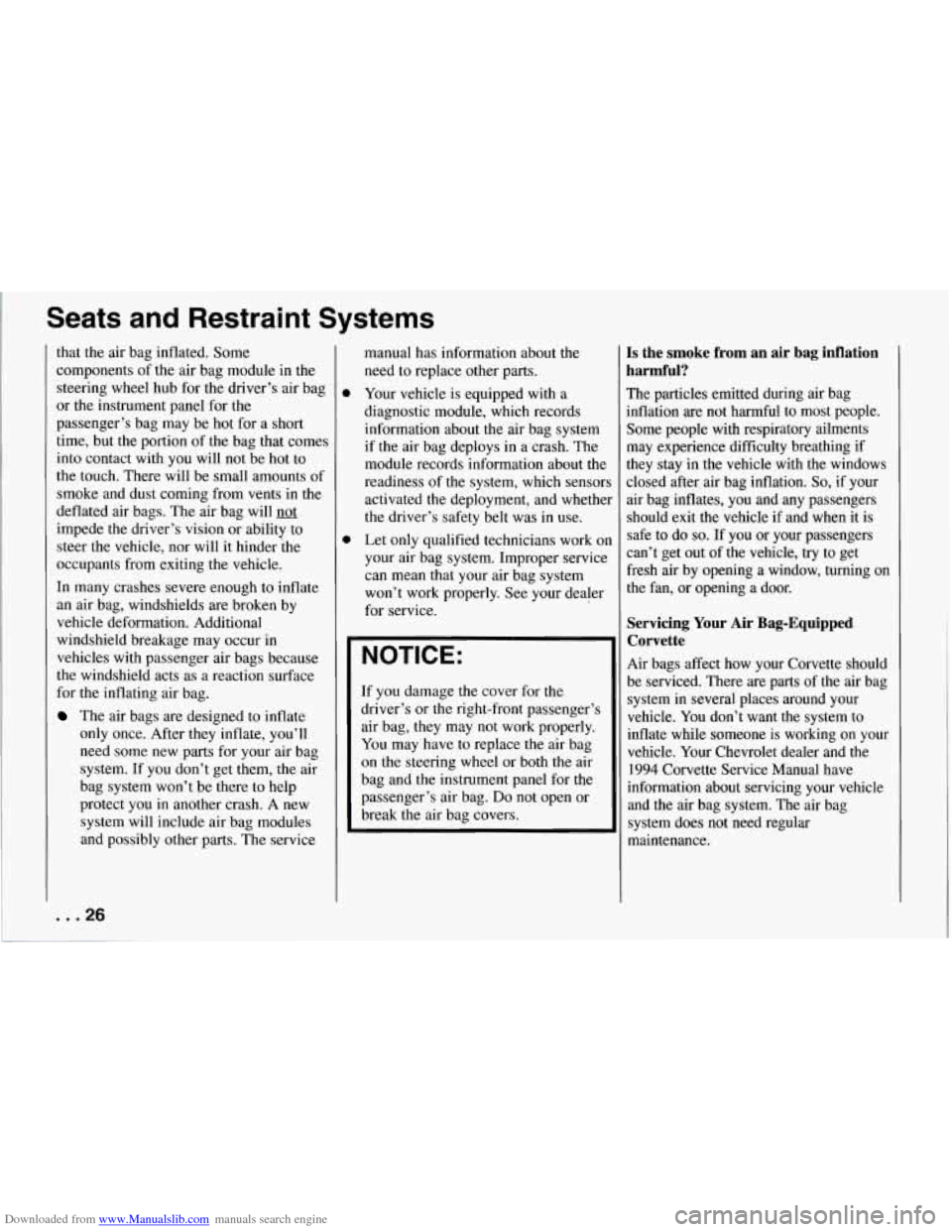
Downloaded from www.Manualslib.com manuals search engine Seats and Restraint Systems
that the air bag inflated. Some
components of the air bag module
in the
steering wheel hub for the driver’s air bag
or the instrument panel for the
passenger’s bag may be hot for a short
time, but the portion of the bag that comes
into contact with you will not be hot to
the touch. There will be small amounts of
smoke and dust coming from vents in the
deflated air bags. The air bag will
not
impede the driver’s vision or ability to
steer the vehicle, nor will it hinder
‘the
occupants from exiting the vehicle.
In many crashes severe enough to inflate
an air bag, windshields are broken by
vehicle deformation. Additional
windshield breakage may occur in
vehicles with passenger air bags because
the windshield acts as a reaction surface
for the inflating air bag.
The air bags are designed to inflate
only once. After they inflate, you’ll
need some new parts for your air bag
system. If you don’t get them,
the air
bag system won’t be there to help
protect you in another crash. A new
system will include air bag modules
and possibly other parts. The service
... 26
manual has information about the
need to replace other parts.
Your vehicle is equipped with a
diagnostic module, which records
information about the air bag system
if the air bag deploys in a crash. The
module records information about the
readiness of the system, which sensors
activated the deployment, and whether
the driver’s safety belt was in use.
Let only qualified technicians work on
your air bag system. Improper service
can mean that your air bag system
won’t work properly. See your dealer
for service.
NOTICE:
If you damage the cover for the
driver’s or the right-front passenger’s
air bag, they may not work properly.
You may have to replace the air bag
on the steering
wheel or both the air
bag and the instrument panel for the
passenger’s air bag.
Do not open or
break the air bag covers.
Is the smoke from an air bag inflation
harmful?
The particles emitted during air bag
inflation are not harmful to most people.
Some people with respiratory ailments may experience difficulty breathing
if
they stay in the vehicle with the windows
closed after air bag inflation.
So, if your
air bag inflates, you and any passengers
should exit the vehicle
if and when it is
safe to do
so. If you or your passengers
can’t get out of the vehicle, try to get
fresh air by opening a window, turning on
the fan, or opening a door.
Servicing Your Air Bag-Equipped
Corvette
Air bags affect how your Corvette should
be serviced. There are parts of the air bag
system in several places around your
vehicle. You don’t want
the system to
inflate while someone is working on your
vehicle. Your Chevrolet dealer and the 1994 Corvette Service Manual have
information about servicing your vehicle
and
the air bag system. The air bag
system does not need regular
maintenance.
Page 29 of 274
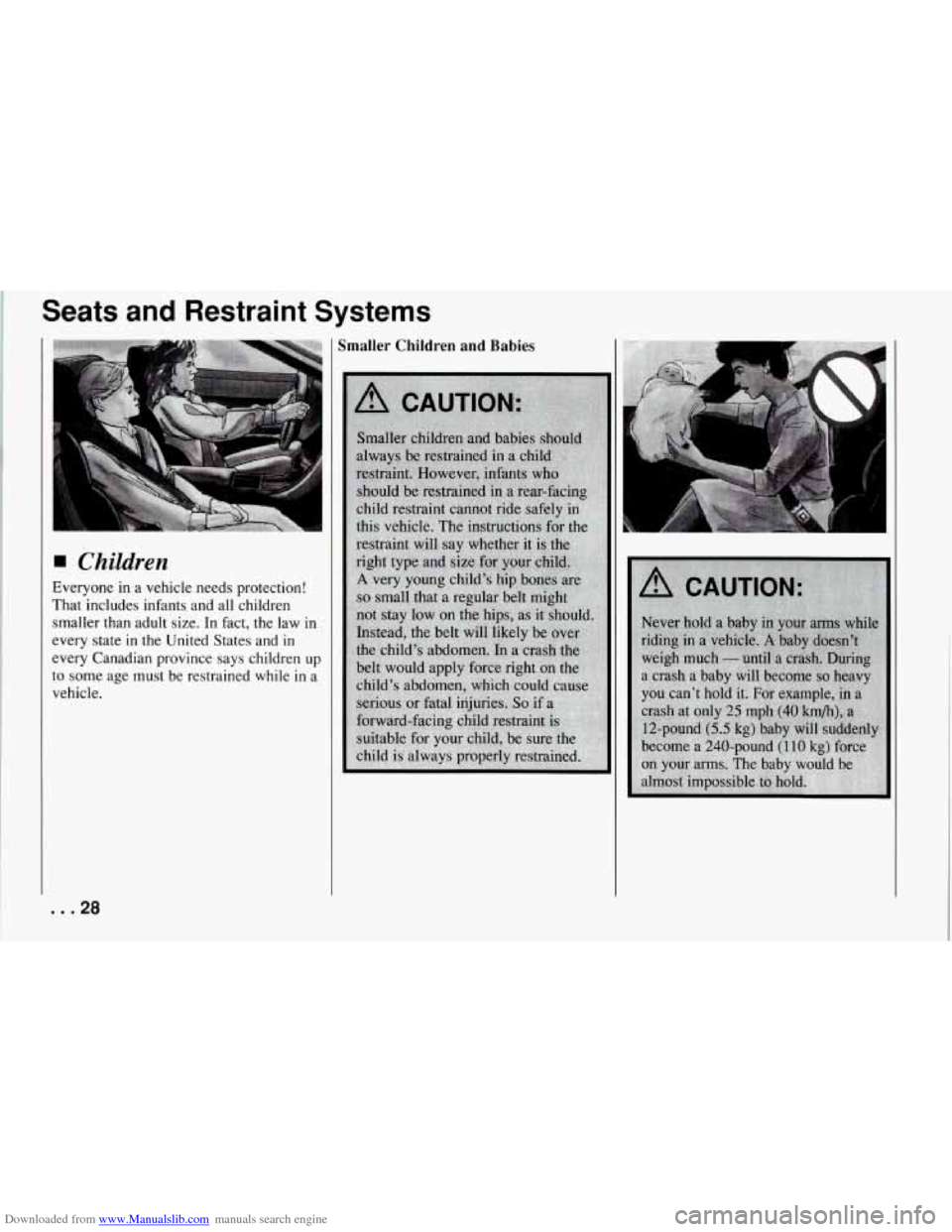
Downloaded from www.Manualslib.com manuals search engine Seats and Restraint Systems
Children
Everyone in a vehicle needs protection!
That includes infants and all children smaller than adult size.
In fact, the law in
every state
in the United States and in
every Canadian province says children up
to some age must
be restrained while in a
vehicle.
Smaller Children and Babies
... 28
Page 31 of 274
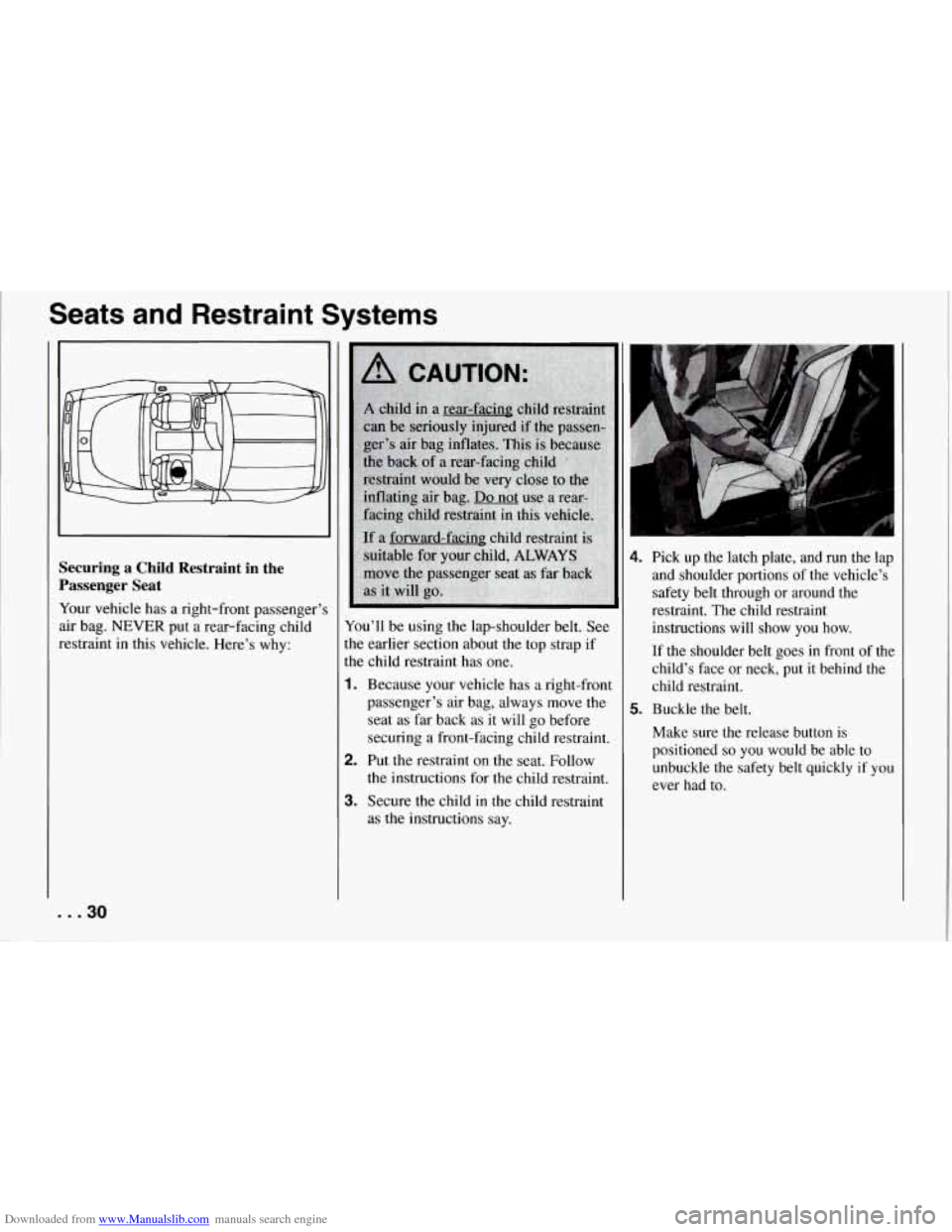
Downloaded from www.Manualslib.com manuals search engine Seats and Restraint Systems
Securing a Child Restraint in the
Passenger Seat
Your vehicle has a right-front passenger’s
air bag.
NEVER put a rear-facing child
restraint in this vehicle. Here’s why:
... 30
You’ll be using the lap-shoulder belt. See
the earlier section about the top strap if
the child restraint has one.
1. Because your vehicle has a right-front
passenger’s air bag, always move the
seat as far back as it will go before
securing a front-facing child restraint.
2. Put the restraint on the seat. Follow
the instructions for the child restraint.
3. Secure the child in the child restraint
as the instructions say.
4. Pick up the latch plate, and run the lap
and shoulder portions of the vehicle’s
safety belt through or around the
restraint. The child restraint instructions will show you how.
If the shoulder belt goes in front of the
child’s face or neck, put it behind the
child restraint.
5. Buckle the belt.
Make sure the release button is
positioned
so you would be able to
unbuckle the safety belt quickly if you
ever had to.
Page 33 of 274
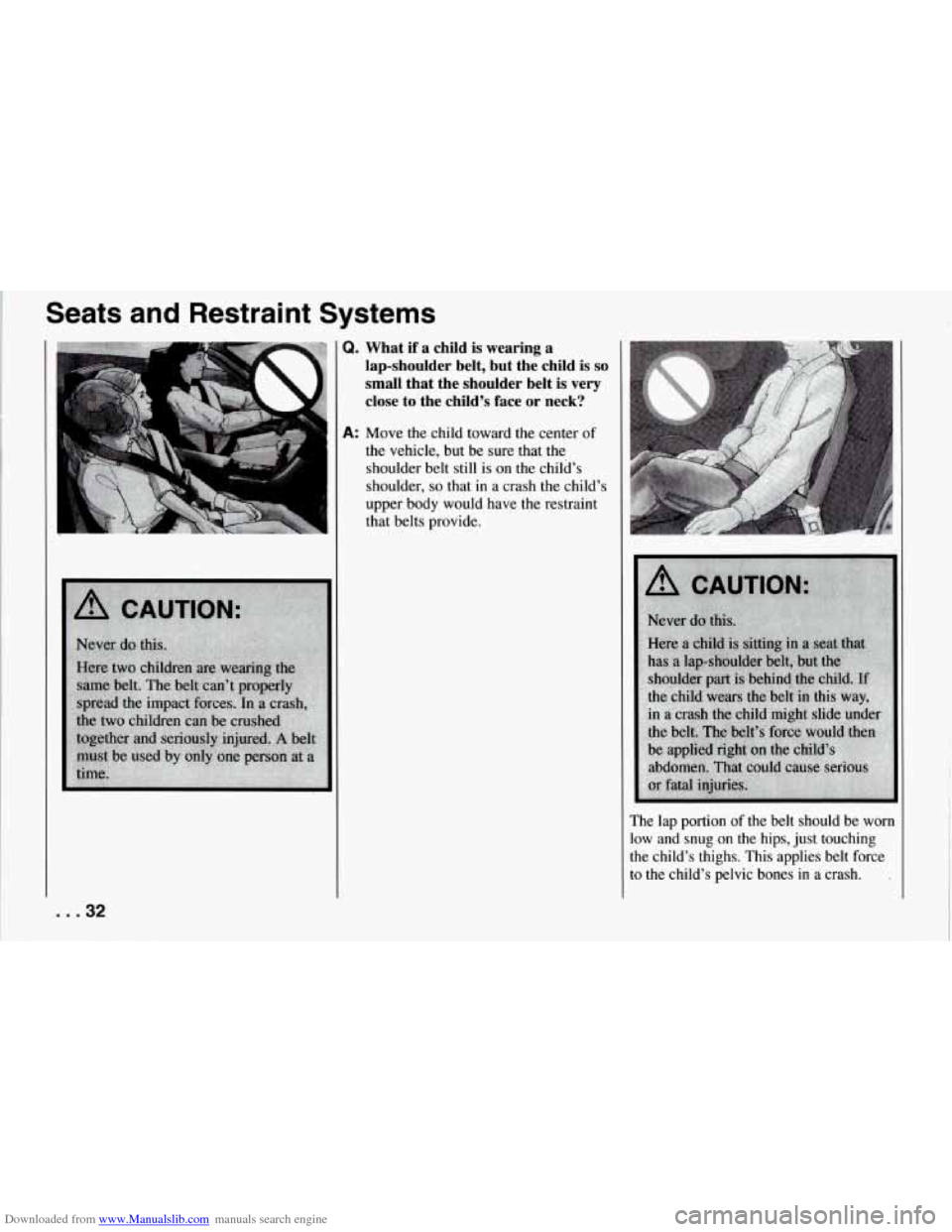
Downloaded from www.Manualslib.com manuals search engine Seats and Restraint Systems
Q. What if a child is wearing a
lap-shoulder belt, but the child
is so
small that the shoulder belt is very
close to the child’s face
or neck?
A: Move the child toward the center of
the vehicle, but be sure that the
shoulder belt still
is on the child’s
shoulder,
so that in a crash the child’s
upper body would have the restraint
that belts provide.
The lap portion of the belt should be worn
low and snug on the hips, just touching
the child’s thighs. This applies belt force
to the child’s pelvic bones in a crash.
.
... 32
Page 35 of 274
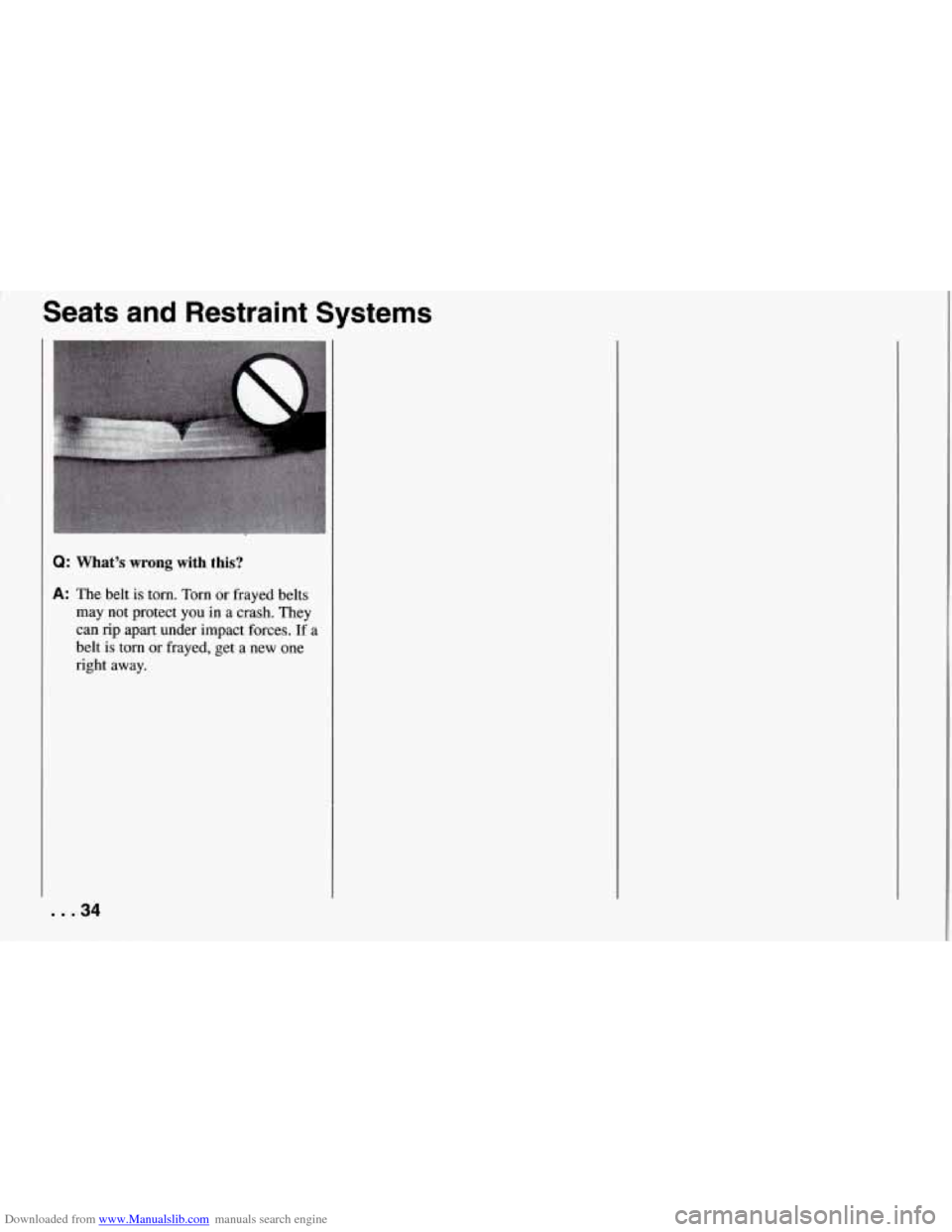
Downloaded from www.Manualslib.com manuals search engine Seats and Restraint Systems
Q: What’s wrong with this?
A: The belt is torn. Torn or frayed belts
may not protect you
in a crash. They
can rip apart under impact forces.
If a
belt
is torn or frayed, get a new one
right away.
... 34
Page 75 of 274
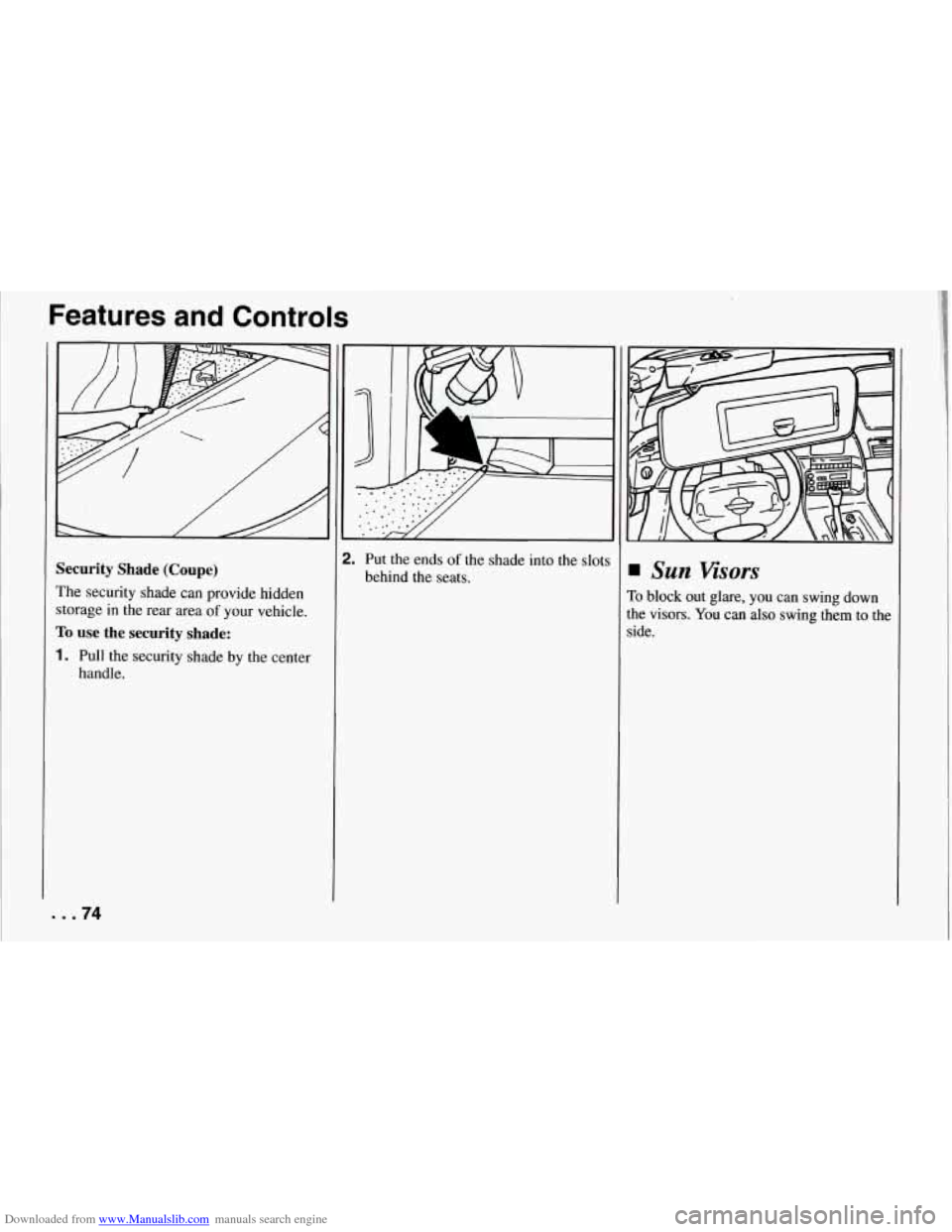
Downloaded from www.Manualslib.com manuals search engine Features and Controls
Security Shade (Coupe)
The security shade can provide hidden
storage in the rear area
of your vehicle.
To use the security shade:
1. Pull the security shade by the center
handle.
... 74
T
2. Put the ends of the shade into the slots
behind the seats.
Sun Visors
To block out glare, you can swing down
the visors. You can also swing them to the
side.
Page 113 of 274
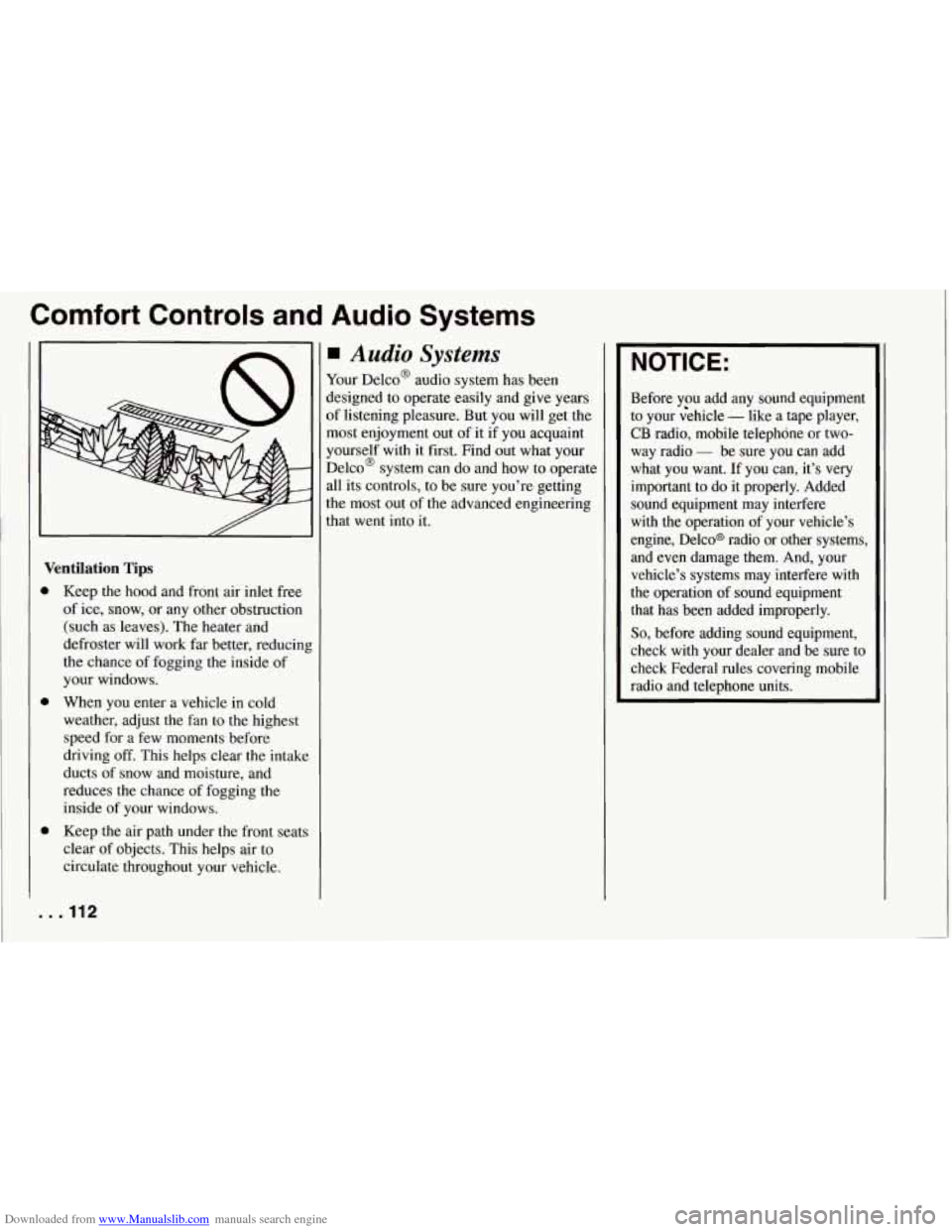
Downloaded from www.Manualslib.com manuals search engine Comfort Controls and Audio Systems
Ventilation Tips
0
0
..
Keep the hood and front air inlet free
of ice, snow, or any other obstruction
(such as leaves). The heater and
defroster will work far better, reducini
the chance of fogging the inside of
your windows.
When you enter a vehicle in cold
weather, adjust the fan to the highest
speed for a few moments before
driving
off. This helps clear the intake
ducts of snow and moisture, and
reduces the chance of fogging the
inside of your windows.
Keep the air path under the front seats
clear of objects. This helps air to
circulate throughout your vehicle.
.I12
Audio Systems
Your Delco@ audio system has been
designed to operate easily and give years
of listening pleasure. But you will get the
most enjoyment out of
it if you acquaint
yourself with it first. Find out what your
Delco@ system can do and how to operate
all its controls, to be sure you’re getting
the most out of the advanced engineering
that went into it.
NOTICE:
Before you add any sound equipment
to your
;chicle - like a tape player,
CB radio, mobile telephone or two-
way radio
- be sure you can add
what you want. If you can, it’s very
important to do it properly. Added
sound equipment may interfere
with the operation of your vehicle’s
engine, Delco@ radio or other systems, and even damage them. And, your
vehicle’s systems may interfere with
the operation of sound equipment
that has been added improperly.
So, before adding sound equipment,
check with your dealer and be sure to
check Federal rules covering mobile
radio and telephone units.
Page 222 of 274
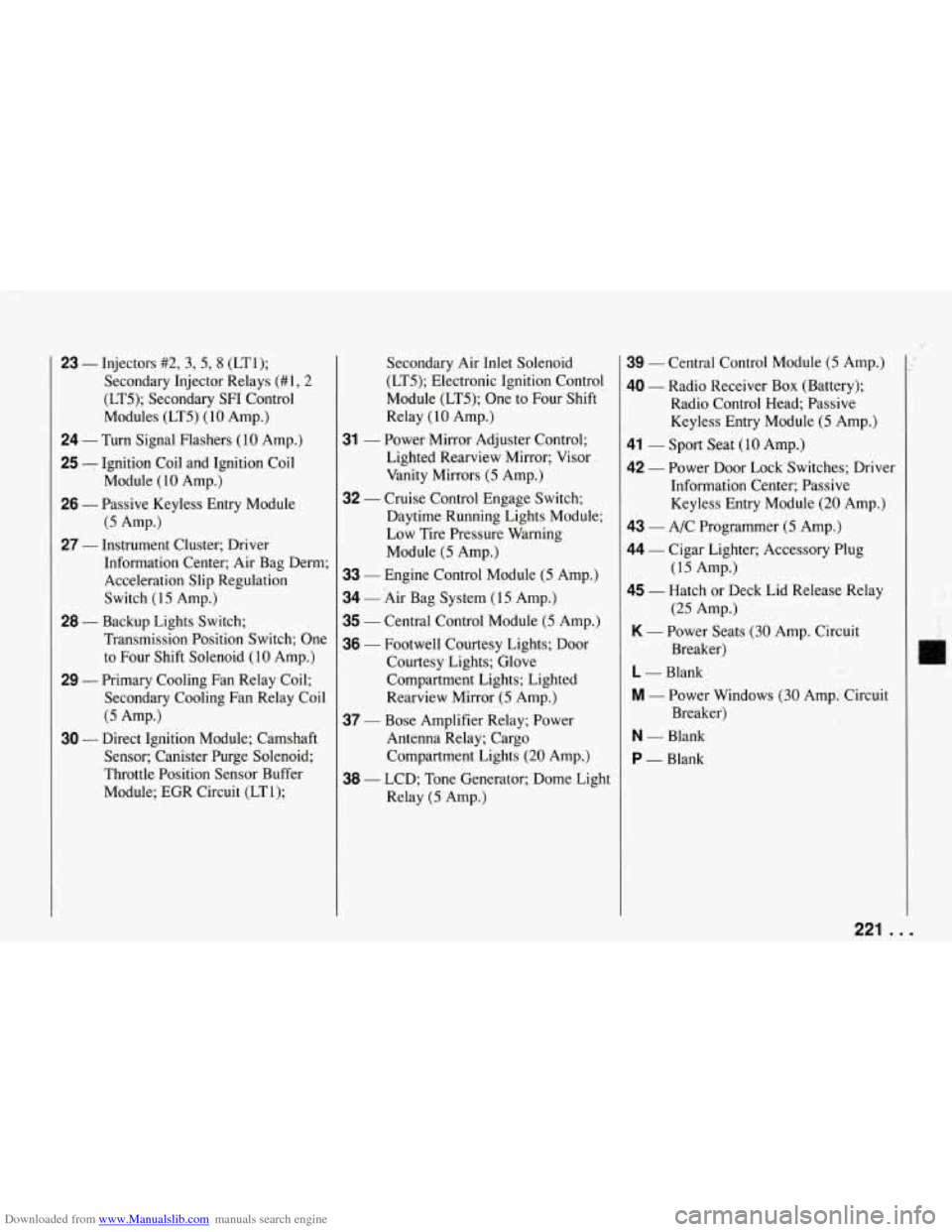
Downloaded from www.Manualslib.com manuals search engine 23 - Injectors #2, 3, 5, 8 (LTI);
Secondary Injector Relays (#1,2
(LT5); Secondary SF1 Control
Modules (LT5)
(10 Amp.)
24 - Turn Signal Flashers (10 Amp.)
25 - Ignition Coil and Ignition Coil
26 - Passive Keyless Entry Module
27 - Instrument Cluster; Driver Module (10 Amp.)
(5 Amp.)
Information Center; Air Bag Derm; Acceleration Slip Regulation
Switch
(15 Amp.)
Transmission Position Switch; One
to Four Shift Solenoid
(10 Amp.)
29 - Primary Cooling Fan Relay Coil;
Secondary Cooling Fan Relay Coil
28 - Backup Lights Switch;
(5 Amp.)
30 - Direct Ignition Module; Camshaft Sensor; Canister Purge Solenoid;
Throttle Position Sensor Buffer
Module; EGR Circuit (LT1);
31
32
Secondary Air Inlet Solenoid
(LT5); Electronic Ignition Control
Module (LT5); One to Four Shift
Relay
( 10 Amp.)
Power Mirror Adjuster Control;
Lighted Rearview Mirror; Visor
Vanity Mirrors
(5 Amp.)
Cruise Control Engage Switch;
Daytime Running Lights Module;
Low Tire Pressure Warning
Module
(5 Amp.)
33 - Engine Control Module (5 Amp.)
34 - Air Bag System (15 Amp.)
35 - Central Control Module (5 Amp.)
36 - Footwell Courtesy Lights; Door
Courtesy Lights; Glove
Compartment Lights; Lighted
Rearview Mirror
(5 Amp.)
37 - Bose Amplifier Relay; Power
Antenna Relay; Cargo
Compartment Lights
(20 Amp.)
Relay
(5 Amp.)
38 - LCD; Tone Generator; Dome Light
39 - Central Control Module (5 Amp.)
40 - Radio Receiver Box (Battery);
Radio Control Head; Passive
Keyless Entry Module
(5 Amp.)
41 - Sport Seat (10 Amp.)
42 - Power Door Lock Switches; Driver
Information Center; Passive
Keyless Entry Module
(20 Amp.)
43 - A/C Programmer (5 Amp.)
44 - Cigar Lighter; Accessory Plug
45 - Hatch or Deck Lid Release Relay
K - Power Seats (30 Amp. Circuit
L - Blank
M - Power Windows (30 Amp: Circuit
N - Blank
P - Blank
(15 Amp.)
(25 Amp.)
Breaker)
Breaker)
221 . I
Page 223 of 274
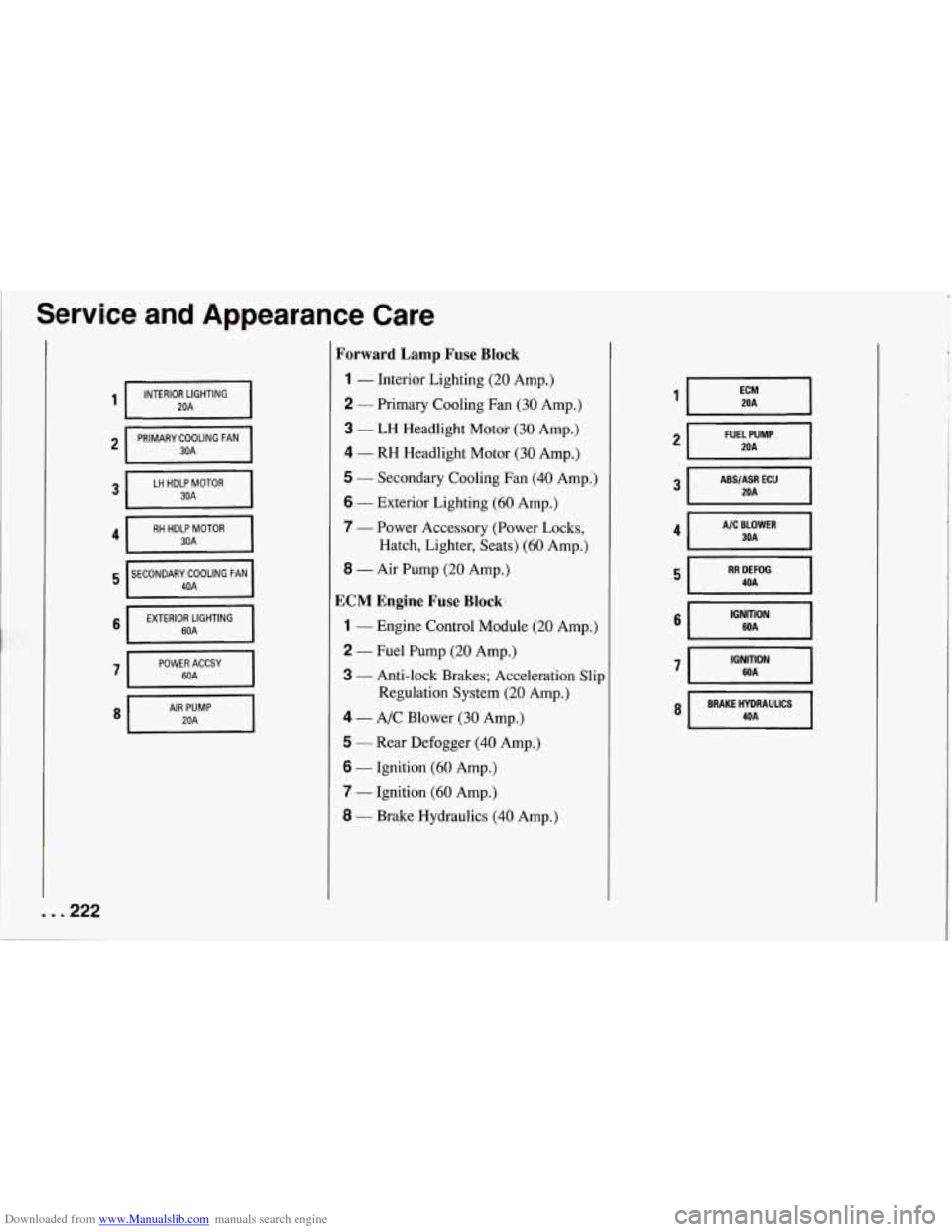
Downloaded from www.Manualslib.com manuals search engine Service and Appearance Care
. . .222
1 I INTERIOR LIGHTING
20A I
I RH HDLP 30A I I I
h 3 5 I SECONDARY COOLING FAN
40A I
6 I EXTERIOR LIGHTING
60A
I
7 piiiFiAAccsy
I
AIR PUMP
20A I
Forward Lamp Fuse Block
1 - Interior Lighting (20 Amp.)
2 - Primary Cooling Fan (30 Amp.)
3 - LH Headlight Motor (30 Amp.)
4 - RH Headlight Motor (30 Amp.)
5 - Secondary Cooling Fan (40 Amp.)
6 - Exterior Lighting (60 Amp.)
7
- Power Accessory (Power Locks, Hatch, Lighter, Seats)
(60 Amp.)
8 - Air Pump (20 Amp.)
ECM Engine Fuse Block.
1 - Engine Control Module (20 Amp.)
2 - Fuel Pump (20 Amp.)
3 - Anti-lock Brakes; Acceleration Slip
Regulation System
(20 Amp.)
4 - A/C Blower (30 Amp.)
5 - Rear Defogger (40 Amp.)
6 - Ignition (60 Amp.)
7 - Ignition (60 Amp.)
8 - Brake Hydraulics (40 Amp.)
FUEL PUMP
ABS/ASR ECU
A/C BLOWER
IGNITION WA I
8 I BRAKE HYDRAULICS 4OA I
Page 247 of 274
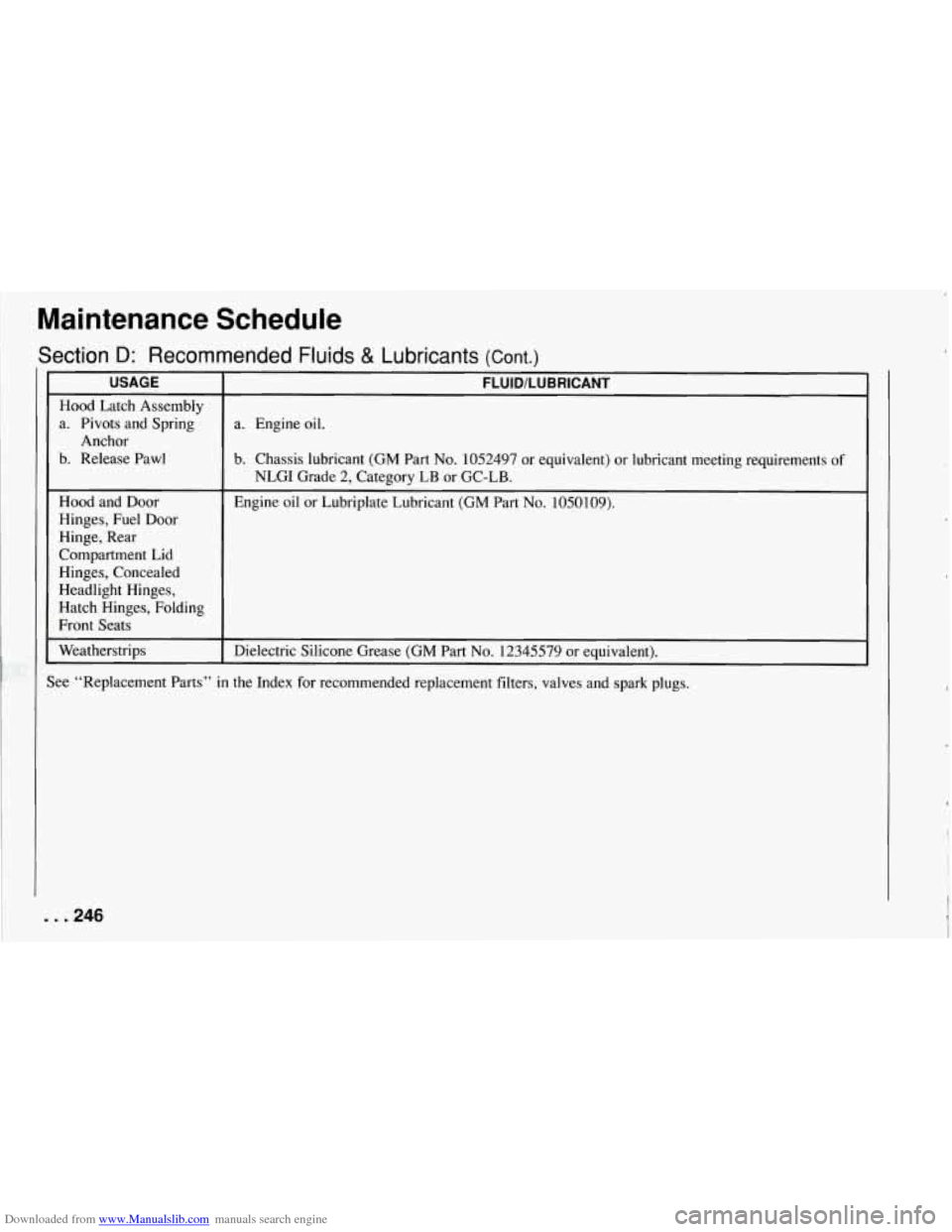
Downloaded from www.Manualslib.com manuals search engine Maintenance Schedule
Section D: Recommended Fluids & Lubricants (Cont.)
USAGE FLUID/LUBRICANT
Hood Latch Assembly
a. Pivots and Spring
b. Chassis lubricant (GM Part No. 1052497 or equivalent)
or lubricant meeting requirements of b. Release Pawl a.
Engine oil.
Anchor
NLGI Grade 2, Category LB
or GC-LB.
Hood and Door
Hinges, Fuel Door
Hinge, Rear
Compartment Lid
Hinges, Concealed
Headlight Hinges,
Hatch Hinges, Folding
Front Seats
Weatherstrips Engine oil
or Lubriplate Lubricant (GM Part No. 1050109).
Dielectric Silicone Grease (GM Part No. 12345579 or equivalent).
See “Replacement Parts” in the Index for recommended replacement filters, valves and spark plugs.
. . .246